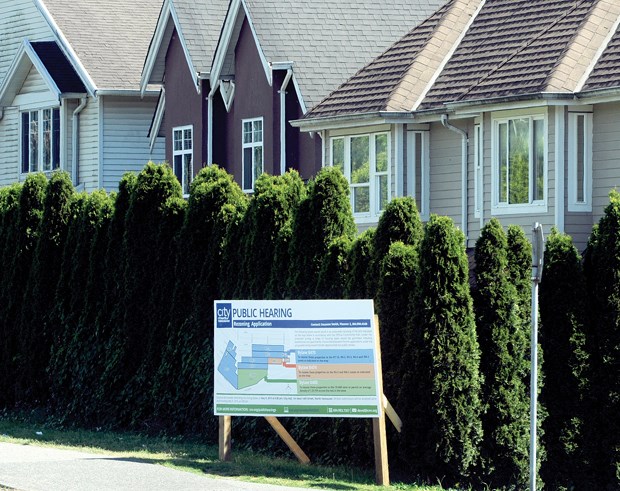After 60 years spent serving as a reminder of the bungalow boom that followed the Second World War, the “future” has come to Moodyville.
Council voted in favour of a massive rezoning Monday that will quadruple Moodyville’s population from 1,000 residents to 4,000 and replace detached homes on 256 lots with approximately 1,890 ground-oriented wood-frame units.
There are still concerns over traffic, transit and what rents will be once the construction dust has settled, but for Mayor Darrell Mussatto the new Moodyville is “a vision for the way the world has to go.”
“This is the future. The days of everybody having a single-family home, unfortunately, are not here anymore,” Mussatto said. “We can’t cut down trees anymore and put in houses. We can’t use the farmland, we can’t fill in the inlet, so our only choice is to do better with what we have.”
Council needs to give the project one more affirmative vote before shovels hit the ground.
The townhouses will hit maximum heights of just under 40 feet and the apartments will be just under 50 feet – with both built according to the building standards of LEED Gold or better.
While Mussatto promised the buildings would be “extremely efficient,” that wasn’t quite enough for Coun. Rod Clark.
By not requiring developers to abide by the energy efficiency and noise mitigation of Passive House, which Clark touted as the building standard of the future, the neighbourhood is “losing out on that once-in-a-lifetime opportunity.”
Moodyville is “under siege” by noise, according to Clark, himself a Moodyville resident.
“Regrettably,” he said, “Moodyville is in the hands of the developers.”
The city is set to take in $30.8 million through density bonus contributions and development cost charges. Approximately one-third of that money is earmarked for utility upgrades and neighbourhood features in Moodyville, but the rest could go toward Harry Jerome Recreation Centre or other city projects, according to a staff report.
For some neighbouring residents preparing to adapt to increased density “forced upon us,” the developers are getting a bargain.
“We should demand more for developing this area since it is, as they call it, ‘a once-in-a-generation opportunity,’” resident Cathy Lewis said. “Once it’s built, it’s done. We should take the time to get it right.”
A city staff report highlighted East Third Street as a future recipient of rapid transit. Parking requirements in the neighbourhood will be slightly lower than in the rest of the city, with 1.2 stalls required for each townhouse instead of 1.5.
In response to concerns about the new residents exacerbating Moodyville’s traffic problems, Coun. Linda Buchanan cautioned that there was no “magic bullet.”
Traffic will only be eased through a conscious effort to change some very old habits, she said.
“If we choose to carry on in the way we have done for the last 50 years, we will end up with gridlock,” she said. “We need to be looking at other means and ways and taking the leadership.”
While the majority of speakers were extremely supportive of the rezoning, there were lingering concerns over whether Moodyville could ever be a home for cash-strapped young people.
Just as with traffic, there is no “magic bullet” for affordable housing, according to Coun. Craig Keating.
“Will it be affordable in the sense that you could rent here for the same price you might rent in a 50-year-old bungalow? Probably not,” he said.
However, relying on the city’s older buildings to provide affordability is only a short-term solution, according to Keating. The long-term solution is to create more supply.
“Housing is a commodity like any other commodity. If you restrict the supply relative to the demand, then ultimately what you end up with is higher costs,” he said.
In a city replete with single-family homes and towers, Moodyville’s wood-frame ground-oriented homes will fill the municipality’s “missing link,” Keating said.
Coun. Holly Back agreed.
“Moodyville is certainly a start to keeping our young people on the North Shore,” she said.
The community support for the rezoning is evidence council has done a good job, according to Back. “How many times do we get where all the neighbours come and they’re happy?”
Council voted 5-2 in favour with Couns. Clark and Pam Bookham opposed.



